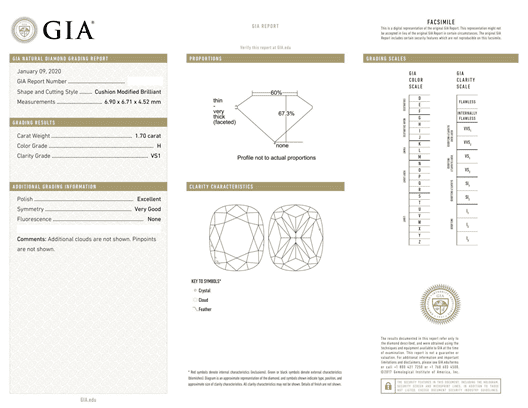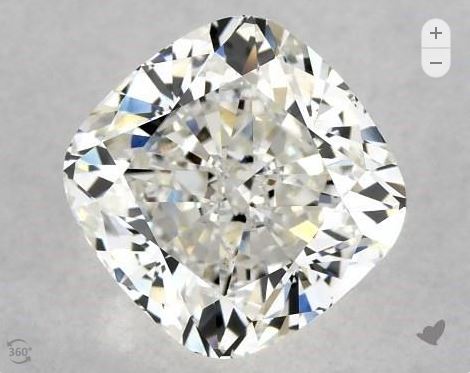We are reader-supported. Buying through any red colored link on our site may earn us commissions. Learn More.
Up to 30% off engagement rings and select jewelry at James Allen!
The Gemological Institute of America (GIA) is the gold standard in diamond grading, ensuring that you’re purchasing a diamond that truly reflects its stated qualities. A GIA diamond grading report provides an unbiased assessment of a diamond’s characteristics, including its 4Cs: carat, color, clarity, and cut. Before investing in a diamond, it’s essential to verify its GIA grading, guaranteeing that you’re making an informed decision based on accurate and trusted information
Here’s what we’ll cover in this article:
What is a GIA Diamond Grading Report?
What are GIA certified diamonds?
How does GIA grade diamonds?
Do all diamonds come with a GIA grading report?
Where to buy GIA graded diamonds
FAQs
Why you should trust us
GIA Diamond Grading Report
A GIA diamond certificate is a report given by the GIA grading a diamond on several key characteristics. The GIA’s report grades on the 4 C’s – carat, color, clarity and cut – as well as polish, symmetry and Fluorescence. The report also gives details on the diamond’s shape and style (round brilliant, for example), its proportions, and any inscriptions or noticeable inclusions.
Let’s say you’re looking at this 1.01 carat, H color VS1 clarity round cut diamond or this 1.70 carat, H color VS1 clarity cushion cut. The GIA grading report gives you the peace of mind that it has been independently graded, and you’re not overpaying for a diamond that should actually be an I color, VS2 clarity.

What Are GIA Certified Diamonds?
When we refer to GIA certified diamonds, we’re talking about diamonds that have a grading report from the GIA laboratory.
This 0.86 carat. G VS1 round brilliant is an example of a GIA certified diamond, as it carries a grading report from the GIA, which verifies its grades in diamond color, cut, clarity and carat.
The term GIA certified diamond is actually not completely accurate, as the GIA grades diamonds, rather than certifying them. However, you may see jewelers and people in the industry talking about “certified diamonds”, so know that this is what they mean.
GIA graded diamonds are a much safer purchase than diamonds graded by almost any other grading entity. This is because the GIA is renowned as one of the most trustworthy and consistent grading labs, meaning their grade is more likely to be a fair representation of the diamond’s quality.
Some labs have a reputation for inconsistent grades, or for grading some aspects (like color or clarity) more generously. This can end up costing you a lot of money on your purchase, as the difference in price from one grade to another is often steep.
How Does The GIA Grade Diamonds?
The GIA exists as an independent, third-party laboratory for grading diamonds. They have no financial stake in the diamonds that go through their lab, and steps are taken to ensure anonymity and complete objectivity with their reports. As the GIA explains, diamonds are graded anonymously, without the graders having any knowledge of their origins or ownership, and graders aren’t informed about previous grades that may have been assigned to the diamonds they review.
That means with a GIA grading report, you can be confident you’re getting a fair and honest representation of the diamond’s qualities. The process is designed to remove any risk of bias or inaccuracy, giving you confidence as a diamond buyer that you’re getting what you pay for.
The most important part of the grading process is the diamond’s 4 Cs – cut, color, clarity and carat. The GIA report gives a grade on each of these qualities, with several graders working independently to ensure a fair and accurate assessment.
The GIA grading report also gives information on the diamond’s proportions, most notably the depth, width and table size, as well as further details such as polish, symmetry, fluorescence, any laser inscription, and a plot of all blemishes or inclusions.
If you check the GIA grading report for this 1.02 carat cushion cut diamond, you’ll see it mentions a “Medium Blue” Fluorescence, as well as the characteristics of its inclusions and blemishes.
These additional qualities are less important than grades like diamond cut, color and clarity, but can still have an impact on the beauty of the diamond.
This article has a deeper look at the qualities and components of the GIA’s grading report.
Do All Diamonds Come With a GIA Grading Report?
Not every diamond has a GIA grading report. A large number do, thanks to the GIA’s reputation as the gold standard in diamond grading, however there are many other grading entities that exist today.
You can find out more about the different labs that do diamond certification, such as the AGS, IGI, EGL, GSI, HRD, and obviously the GIA, in this article.
When you shop for a diamond, the vendor should provide information on which entity the diamond has been graded by. The GIA diamond grading report also features a unique number, which you can use to verify the report on the GIA’s website.
Where to Buy GIA Diamonds
James Allen
James Allen is one of the best online diamond retailers, known for their commitment to customer satisfaction, great range and excellent value. They offer a huge selection of loose diamonds, with the technology to allow you to inspect diamonds in detail online.
A large number of James Allen’s inventory come with a GIA certificate. However, they also carry diamonds graded by the AGS and IGI, so be sure to check which lab has provided the grading report when inspecting a diamond. If you want to stick to GIA diamonds only, they give you the option to filter by a specific lab when shopping.
Browse James Allen’s selection of GIA certified natural diamonds here.
Blue Nile
Featuring one of the largest inventories of any online diamond retailer, Blue Nile’s selection of over 250,000 loose diamonds is hard to beat. They offer just about any shape or style of diamond you’d likely be looking for, many of which have 360° viewing technology for easy inspection.
Unlike James Allen, all Blue Nile’s inventory is graded by the GIA, which makes it easier to compare diamonds on their site, knowing they’ve all been through the same lab’s grading process.
Browse Blue Nile’s range of GIA diamonds here.
FAQs About GIA Diamond Certification
GIA grade diamonds can seem more expensive when compared to diamonds graded by other labs. You may be able to find diamonds with a similar grade (as per the grading report) at a cheaper price with other labs’ grading reports. However, the grades of some of them tend to be looser, meaning you may be paying for what you think is an H color VS2 clarity diamond when in reality it should be a J SI2.
The GIA’s grading process is slightly more expensive than some other labs, and the grades they give are stricter than low-quality labs like the EGL. However, this is a small price to pay to ensure you’re buying a diamond with a fair and accurate certificate.
The GIA is regarded as a higher-quality grading entity than the IGI. IGI certified diamonds tend to be graded significantly looser than GIA diamonds, meaning the same diamond is likely to have an inflated grade (and thus price, too), from the IGI.
The IGI also has different labs around the world, which provide inconsistencies in the strictness of their grades. For more, read our guide on the IGI certification process and why it doesn’t stack up to the GIA.
The American Gem Society, or AGS, is another trustworthy grading entity. Their grading report covers the same qualities and characteristics as the GIA’s, with only slight differences in how they express their grades. Cut, for example, is graded on a scale of 0 to 10, along with descriptive wording. 0, or Ideal (here is an example of such a diamond), is the highest, while 8-10, or Poor, is the lowest.
As far as the quality of the AGS grading process goes, there is little to separate theirs and the GIA’s. You would be best served sticking with either of these two reports when shopping for a diamond.
You can learn more about the AGS certification and how it compares to the GIA in this article.
The GIA does grade lab-grown diamonds. Since lab-grown diamonds are identical, chemically and visually, to natural Earth-grown diamonds, the GIA grades them on the same scale of the 4 C’s.
The only difference with GIA diamond grading reports for lab diamonds is that it specifies that the diamond is laboratory-grown, and comments note whether the diamond was produced via CVD (Chemical Vapor Deposition) or HPHT (High Pressure High Temperature).
How much does it cost to get a diamond GIA certified?
How much does it cost to get a diamond GIA certified?
Final Thoughts
A diamond grading report from the Gemological Institute of America is one of the best ways to ensure you’ve not been duped into paying for a diamond that doesn’t live up to its grades.
For example, if you’re spending over $10,000 on a beautiful, near-flawless diamond like this, you need to know the grades shown are accurate.
Just one grade up or down in diamond clarity, color and cut can have a huge difference in the price. That’s why it’s vital that the grades you’re looking at have been given by a trustworthy and reputable grading lab, who are recognized in the industry for giving fair and accurate reports.
We always recommend buying diamonds that have a GIA grading report. If you have any questions, our team of experts will be happy to answer them and help you find a well cut and priced diamond.
Here are more specific certificate topics to browse:
- What diamond certification is the best?
- How does AGS certification compare vs. GIA?
- Is IGI diamond certification good / how does it compare vs. GIA?
- How does EGL certification compare vs. GIA?
- How does HRD certification compare vs. GIA?
- Is GSI diamond certification good / how does it compare vs. GIA?
- Does GIA or IGI certify lab-grown diamonds?

- No questions asked returns within 30 days of shipment. James Allen will send you a paid shipping label to return the ring.
- Lifetime Warranty
- Free International Shipping
- Free prong tightening, repolishing, rhodium plating and cleaning every 6 months
- Provide insurance appraisals
- One free resizing within 60 days of purchase
- Free ring inscriptions
- Best-in-class high quality imagery of all diamonds in stock
- 24/7 Customer Service
- Best-in-class packaging


- No questions asked returns within 30 days of shipment. Blue Nile will send you a paid shipping label to return the ring.
- Lifetime Warranty
- Free Shipping
- Free prong tightening, repolishing, rhodium plating and cleaning every 6 months
- Provide insurance appraisal
- One free resizing within the first year of purchase
- High quality images of about half of their diamonds
- 24/7 Customer Service
- 100% credit towards future upgrades (must be at least double in value)
- Best in class fulfillment

Still afraid of getting ripped off?
Before you buy a diamond, get personal buying advice from industry veterans. We'll help you get the best diamond for the money.
Ask your diamond purchase question here
DISCLAIMER: We don't use your email for marketing. Period.
You Might Like
Diamond Prices: A Complete Guide
A diamonds’ price is determined primarily by the 4 Cs of the diamond. On the wholesale level, diamond prices are first based on a diamond shape and
The Best Places to Buy Engagement Rings
Buying an engagement ring is often one of the first major purchases in a person's life. The process can be fraught with tension as there are so m
1 Carat Diamond Price & Buying Guide
A wide range of 1 carat diamonds exist both in online markets and local diamond jewelry stores. Not only are there significant differences in beauty




